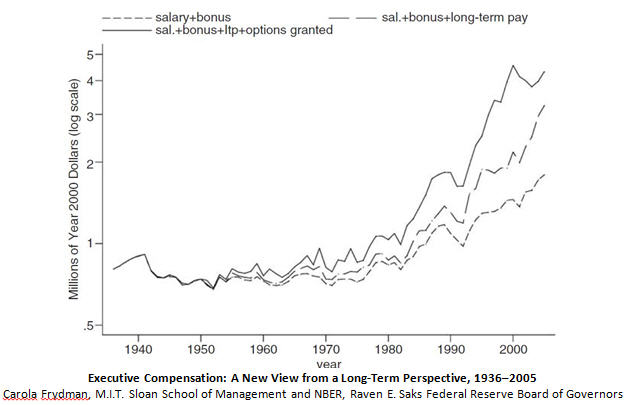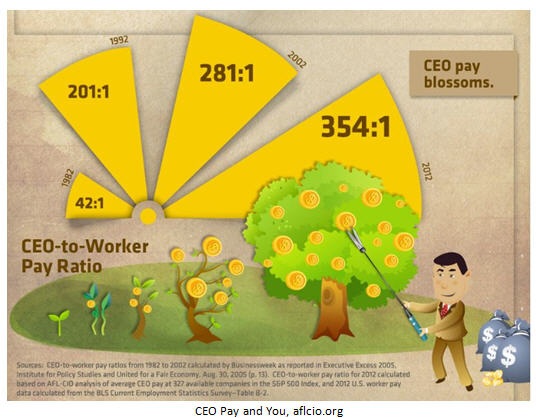Richer than you
Income inequality in Canada and the United States is on the rise. Most of the published articles today, as to why income inequality is rising, are dead wrong. Read on to learn the real reason…
The Canadian Centre for Policy Alternatives (CCPA) analysis of income inequality data shows the richest one percent of Canadians make $180,000 more today – adjusted for inflation – than they did in 1982.
The bottom 90 percent of Canadians saw income gains of only $1,700 over the same time period. In Vancouver, Toronto, and Montreal – Canada’s three largest cities – the bottom 90 percent actually make less today than they did in 1982.
Most Canadians living in these cities have seen drops in income of:
- Vancouver = $4,300
- Toronto = $1,900
- Montreal = $224
The richest one percent of Canadians in these three cities cities saw pay increases of:
- Vancouver = $189,000
- Toronto = $297,000
- Montreal = $162,000
 There are shocking disparities in income inequality in America…
There are shocking disparities in income inequality in America…
David Cay Johnston, a Pulitzer Prize winner writing for Tax Analysts says that between 1966 and 2011, average inflation-adjusted income of the bottom 90 percent of US workers grew by just $59 while the income of the top 10 percent of workers grew by $116,071 – an astonishing, and frightening, 1,967 times the bottom 90 percent income growth rate.
The top one percent have enjoyed 81 percent of all the increased income since 2009.
The truly astonishing fact here is that it takes only $110k a year to be a top 10 percent earner in the U.S.! Getting into the top one percent is a stretch being over three times higher at $366k while joining the exclusive top .01 percent takes a whopping $8 million yearly income. In Canada, to join the top one percent club of 255,000 taxpayers, your income would have to have exceeded $200k. The threshold for the 25,475 Canadians that make up the top 0.1 percent was $685,000.00 of income.
Why such growth in income inequality?
Most would tell you, are telling you, it’s because…
Stocks and bonds are going up while the housing market remains flat. The top 10 percent have most of their wealth concentrated in stocks etc., less affluent households have their wealth in the value of their home – housing prices remain well below their 2006 peak while U.S. stock indices have all recently hit records.
Some will say falling top marginal tax rates in Canada explain part of the wealth disparity and income rise for the richest one per cent in that country.
A few will point out that the increase in inequality, in both countries, can also be attributed to institutional forces:
- Declines in unionization rates
- Stagnating minimum wage rates
- Deregulation
- National policies that favor the wealthy
All the reasons above show why the bottom 90 percent are getting poorer or at best have stagnating incomes but at best they explain only partially why the rich are getting so much richer and the income gap is widening.
Consider what Stephen McNamee and Robert Miller, authors of The Meritocracy Myth have to say:
- 20% of American households receive 50% of all available income
- The lowest 20% of households receive less than 4%
- The top 5% of households receive 22% of all available income
- The richest 1% of households account for 30% of all available net worth
- Economic inequality in the U.S. is the highest among all industrial countries
The Wall Street Journal reported the top .01 percent (14,000 American families) hold 22.2 percent of wealth, and the bottom 90 percent (133 million families), just 4 percent of the nation’s wealth.
In 1980 the richest one percent of America took home 1 of every 15 income dollars. Now they take home 3 of every 15 income dollars. The share going to the richest 0.01 per cent quadrupled, from one percent to almost five percent.
Why are the rich getting so much richer? It’s obviously more of a long term trend then something that just recently started to happen, what’s going on?
Lavish Compensation
The super affluent have historically relied mostly on unearned income from financial assets, stocks and bonds etc., but for the last 40 odd years that income has slowly taken a backseat to the compensation they are paid.
Canadian Centre for Policy Alternatives researcher Armine Yalnizyan found
“the income of the richest 1 per cent is due mostly to the lavish sums they are paid for the work they do.”
Paul Krugman, winner of the 2008 Nobel Prize in Economics says asset ownership by the super-rich “Is no longer the main source of elite status. These days even multimillionaires get most of their income in the form of paid compensation for their labor…Needless to say we’re not talking about wage slaves toiling for an hourly rate. If the quintessential high-income American circa 1905 was an industrial baron who owned factories, his counterpart a hundred years later is a top executive, lavishly rewarded for his labors with bonuses and stock options. Even at the very top, the highest 0.01 percent of the population—the richest one in ten thousand—almost half of income comes in the form of compensation.”
USA Today’s 2012 CEO’s Compensation analysis focused on 170 S&P 500 companies that filed proxies since Jan. 1, 2013, and were processed by March 22.
The median amount CEOs took home in 2012, including cash bonuses and stock and options awarded in previous years that vested or were cashed in, was $10.2 million.
Pay and total compensation numbers listed in USA Today’s report are incredible, here’s just four of the many:
Miles White, Abbott Labs, $19 million
David Pyott, Allergan, $19.4 million
Kenneth Chenault, American Express, $28 million
Randall Stephenson, AT&T, $21 million
Conclusion
It would seem the rich, in both Canada and the U.S., are getting richer while everyone else is getting poorer.
“Only twice before over the last century has 5 percent of the national income gone to families in the upper one-one-hundredth of a percent of the income distribution…Such concentration at the very top occurred in 1915 and 1916, as the Gilded Age was ending, and again briefly in the late 1920s, before the stock market crash…The great fortunes today are largely a result of the long bull market in stocks, Mr. Volcker said. Without rising stock prices, stock options would not have become a major source of riches for financiers and chief executives. Stock prices rise for a lot of reasons, Mr. Volcker said, including ones that have nothing to do with the actions of these people. The market did not go up because businessmen got so much smarter.” Louis Uchitelle, The Richest of the Rich, Proud of a New Gilded Age
The truth of, and the consequences from, such lopsided income inequality and wealth disparity should be on all our radar screens. Is it on yours?
Contact Richard (Rick) Mills via rick@aheadoftheherd.com
Richard is the owner of Aheadoftheherd.com and invests in the junior resource/bio-tech sectors. Get in touch with him if you’re interested in learning more about the junior resource and bio-med sectors, and quality individual company’s within these sectors.
His articles have been published on more than 400 websites, like the Wall Street Journal, Market Oracle, USA Today, National Post, Montreal Gazette, Vancouver Sun, CBS news, Calgary Herald, Resource Investor, Forbes and Financial Sense.
For Richard Mills’ legal notice/disclaimer, see Aheadoftheherd.com
More News
Rio Tinto, Founders Factory’s Mining Tech Accelerator invests in startups from US and OZ
April 23, 2025 | 04:02 pm
{{ commodity.name }}
{{ post.title }}
{{ post.date }}






Comments